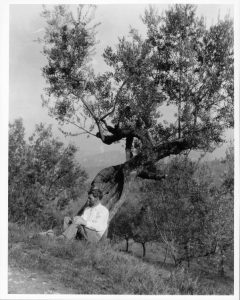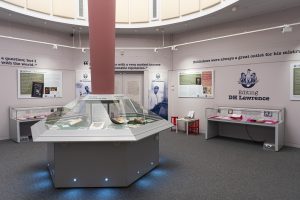May 10, 2022, by Kathryn Steenson
Reflections on Editing DH Lawrence
This is a guest post by Dr Rebecca Moore, Exhibitions Officer.
As Editing DH Lawrence enters its fourth and final month at the Weston Gallery, my thoughts turn naturally to reflecting on the exhibition. After hosting many wonderful events, one question from visitors was often repeated: ‘What do you think Lawrence would have made of all this then?’
There are, I think, at least two answers to this. The first would be Lawrence’s utter incredulity that the University of Nottingham would host such a celebration of his work – given that, in no small part due to his running off with the wife of a respected professor here, Lawrence was not celebrated at the then University College during his lifetime and for quite some time afterward. The second is related to Lawrence’s thoughts on museums and exhibitions more generally. In his series of sketches of Tuscany, published posthumously as Etruscan Places in 1932, Lawrence states:
‘Museums anyhow are wrong. But if one must have museums, let them be small, and above all, let them be local.’
So far, so good. If you have been to the Weston Gallery you will know it is on the cosy side, and what could be more local than displaying work by Nottinghamshire’s favourite* writer?

Photograph of D.H. Lawrence under an olive tree at Villa Mirenda, Italy, c. 1926 – 1928. Ref: La Phot 1/24
Lawrence disagreed with artefacts being taken out of their original contexts and placed in museums, and though he is writing here about ancient Etruscan artefacts, there is a suggestion of how he might interpret the Editing DH Lawrence exhibition in this extract:
‘Museums, museums, museums, object-lessons rigged out to illustrate the unsound theories of archaeologists, crazy attempts to co-ordinate and get into a fixed order that which has no fixed order and will not be co-ordinated! It is sickening! Why must all experience be systematized?’
We try our best, as curators, to ensure our theories are sound, and indeed, it is modern museological practice to not enforce readings of objects onto the viewer, but I feel we may be guilty of systematizing experience. Exhibitions are stories, after all, and it is useful to think of each case as a different chapter of the larger story of the exhibition and this requires some level of systematization.
Lawrence continues:
‘A museum is not a first-hand contact: it is an illustrated lecture. And what one wants is the actual vital touch. I don’t want to be “instructed”; nor do many other people.’
So, what would an ideal exhibition look like for Lawrence? Perhaps we should get rid of all those pesky instructional captions, open up the cases and let visitors try on the poncho and sandals while leafing through stacks of letters, photographs and manuscripts? I don’t think that would go down very well in the conservation department.
It does give one pause however, to think about how we can make exhibitions more ‘vital’ – and I hope that we have done that in ways that don’t involve literal touch. I am very proud of the events programme which has been running alongside Editing DH Lawrence, creating discussion, prompting questions, and inviting creative responses from members of the wider community. This, I hope would serve as the ‘first-hand contact’ Lawrence was looking for.
Editing DH Lawrence runs until Sunday 29th May 2022 at Lakeside Arts, at the Weston Gallery, open Tuesday-Sunday 12noon-4pm.
*Of course, it depends who you ask …
No comments yet, fill out a comment to be the first


Leave a Reply